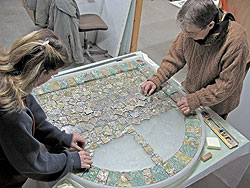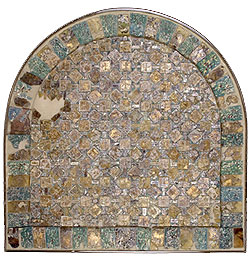
IAA Conservators working on the Glass Panel
The glass panel is complete; it is in the shape of the Greek letter sigma and is made of glass platelets and gold that were combined together to form a geometric pattern. This panel is the first of its kind to be exposed in an archaeological excavation in the country; it is unique both from the standpoint of its state of preservation and that of its quality and nature, and to the best of our knowledge, it is the only one of its kind in the world.
The panel (103 x 103 centimeters) was uncovered during a salvage excavation that was conducted on behalf of the Antiquities Authority in Caesarea. Conservation work was being carried out during the winter of 2005 in order to prepare the Bird Mosaic for display to the general public. During the course of the excavation, under the direction of Dr. Yosef Porat, the remains of a palace’s rooms were exposed that were paved with mosaics and the glass panel was discovered lying face down on the floor in one of them. The panel was covered by the collapse of the second story that included among other things fragments of mosaic floors, a stone table, pieces of plaster and roof tiles. The panel is dated to the latter part of the Byzantine period (the late sixth century and beginning of the seventh century CE), a date that corresponds with that of the building and the other artifacts that were discovered inside it during the course of the excavation.

The Glass Panel after completion of the conservation work
A layer of broken ceramic amphorae was arranged neatly along the back side of the panel’s frame so as to elevate it from the middle part of the panel, similar to the edges of stone and marble tables that are characteristic of the period. In light of this the panel is also known as the “gold-glass table”.
The panel is unique in that the glass platelets inlaid in it were made using two techniques: most of the platelets were made by a special technique of ‘gold-glass’; there are platelets that were made of multicolored, opaque glass known as ‘mosaic glass’.
The ‘gold-glass’ platelets were made of two layers of glass (the bottom layer four to five millimeters thick and the upper layer less than one millimeter thick) between which is very thin gold foil (so thin it cannot be measured). The ‘gold-glass’ platelets occur in a variety of shapes and sizes: squares, rectangles and triangles. Many of them are decorated with a relief pattern that was made in a mold while the glass was still hot and which stands out from the surface of the platelet.
The process of manufacturing the platelets was very complicated and required special expertise. The platelets are decorated with two motifs: a molded cross and an eight petalled rosette.
The ‘gold-glass’ platelets are also used in the frame and in the guilloche. They were made of multicolored, translucent glass incorporating glass occurring in shades of green, red, yellow and grayish blue. They were not adorned with a specific pattern, rather there are polychrome splashes set against a uniform colored background. These platelets were made in molds that were filled with ground glass which was melted to the desired shape. The use of several shades of opaque glass, like the tesserae that decorated floors and walls, is a common practice known in the Byzantine period, but platelets and tiles that were made in this manner are extremely rare among the finds of the period.
The panel was treated by the Conservation Department in cooperation with the Glass Department of the Antiquities Authority. The panel was removed from the site and transferred to the laboratories of the Antiquities Authority for the purpose of conservation and documentation. The panel was mapped in the laboratory; each of its platelets was cleaned by means of several processes and was returned to its place. The panel has been provided with a new support that consists of a transparent box. The Glass Panel was conserved and restored due to generous funding from Tom and Margot Pritzker.
Additional Articles ...